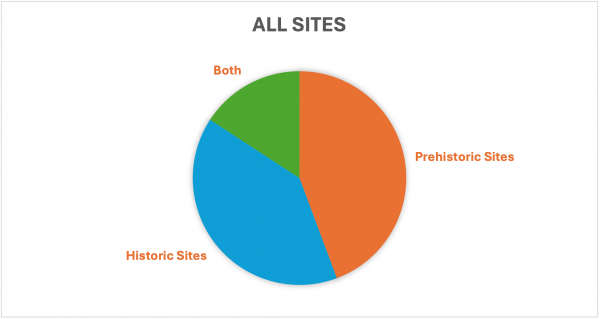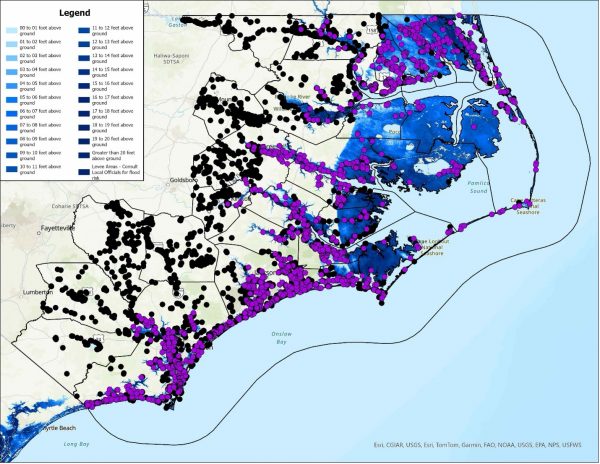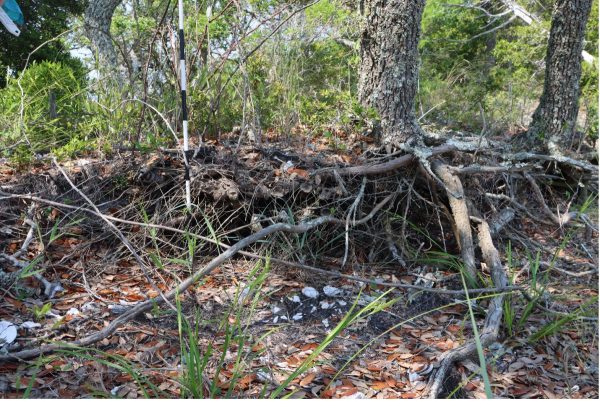By Allyson Ropp, Historic Preservation Archaeological Specialist
As I write this, North Carolina faces a long road of recovery in its western reaches. Hurricane Helene sped through the west, dumping several feet of rain and generating a thousand-year flood event. This was a mere week after the southeastern portion of North Carolina also faced a massive flood event, caused by a random low-pressure system off the coast. These events wrecked immense damage to the people and towns within these regions, and many places are still recovering. These storms also separated people from place, damaging their connection to tangible and intangible resources. The questions now arise about what has happened to archaeological sites and how did these storms impact them.
These storms are not unknown to North Carolina. Since 2015, 28 tropical storms and hurricanes have come through the state, including Hurricanes Florence and Michael in 2018. Like Hurricane Helene, these storms caused immense loss of life and economic impacts. These storms also caused documented damage to cultural resources. These storms precipitated the release of funds from the National Park Service’s Emergency Supplemental Historic Preservation Fund (ESHPF). North Carolina received $9 million in funding to support internal and local community projects concerning historic property reconstruction and stabilization and archaeological site assessment and evaluation to impacts by hurricanes. The NC Office of State Archaeology (OSA) received about $1 million to complete two projects: one focused on the impact on historic cemeteries within coastal counties and one focused on the impacts on archaeological sites within intertidal shorelines.
To begin these projects, it was essential to identify sites across the coastal counties that would be impacted by hurricanes, as represented by storm surge, and additional environmental change, including sea level rise. While the ESHPF projects limited work to FEMA-eligible counties, we expanded this desk-review to encompass all 32 coastal counties. This desk-review calculated the number of sites across these counties, their identified cultural affiliation, site type, elevation, and distance to the nearest waterway. In total, 14,874 sites were identified across these counties, with an even spread between historic, prehistoric, and multicomponent sites (Figure 1).

Figure 1. Breakdown of sites within the Coastal Plain (Photo courtesy of OSA 2024).
These sites were then compared to hurricane storm surge models over all five categories of storms. This showed that over a third of the sites in coastal counties would be impacted by Category 5 hurricane storm surge, and about a quarter for both Category 3 and Category 4 storms. At a county level, impacts varied depending on the proximity to the ocean and riverways (Figure 2). This includes almost complete inundation of Camden, Carteret, Currituck, Dare, Hyde, Pamlico, Pasquotank, Perquimans, Tyrrell, and Washington counties (Figure 3).

Figure 2. The number of sites per county impacted by storm surge from hurricanes. The inner ring represents sites impacted during Category 1 storms and the outer ring represents those impacted by Category 5 storms. The level of impact grows as the size of the storm grows (Photo courtesy of OSA 2024).

Figure 3. Archaeological sites impacted by storm surge of a Category 5 hurricane. Purple dots are those impacted by the storm surge, where the black are the remainder in the area not impacted by storm surge (Photo courtesy of OSA 2024).
Using this information and the ESHPF requirements, OSA set out to conduct ground-truthing to understand the impacts of hurricanes and other environmental changes to archaeological resources and cemeteries. Using a ranking system that accounted for environmental and historical priority, several areas were identified for the survey, including Hammocks Beach State Park in Onslow County, the Scuppernong River Section of Pettigrew State Park, and the Alligator River Game Lands in Tyrrell County (learn more about the process of prioritization and selection).
These areas underwent surveys from September to December 2023 by AECOM. After conducting miles of survey across all areas, AECOM presented the results to OSA. These results indicate difference in location in determining the level of impact from hurricanes and other environmental changes. Hammocks Beach State Park, a barrier island environment, is home to sites dating from the Woodland period through today, including several large indigenous occupation sites and a Civil War fort. Because of the barrier island environment, these sites are exposed to daily sediment movement and wind-driven fetch that dominant site formation process. The Alligator River Game Lands is a large tract of land in northern Tyrrell County along the Albemarle Sound and Alligator River. The identified sites represented colonial and early statehood occupation through maritime industries of the 20th century. Like Hammocks Beach, wind-driven waves drive processes along the Albemarle Sounds. However, sites along the Alligator River side are more protected from such wave action as they are tucked around a corner. Due to the swampy nature of the Scuppernong River, only one site was identified. As the site sits in 10 ft. of water and is tucked around a corner, it is unlikely that daily wave activity impacts the site.
During each category of storm, all three project areas are inundated, particularly along the shorelines where these sites were identified. This inundation from storm surge has immense impact on the stability of the sites. Many of the sites are buried and already eroding. The amount of force behind storm surge waters can further destabilize and erode these sites, causing undercutting and areas of collapse (Figure 4). Storm surge also destabilizes sediments surrounding built components of sites, leading to structural collapse. This effect was documented on several sites in the survey areas. Overall, these projects served two purposes. First, they began the process of conducting macro-scale analysis of hurricanes and sea level rise impacts on sites across the Coastal Plain. Second, they provided the opportunity to ground-truth these impacts to sites and discover new sites along the shorelines before their context is changed by hurricanes and large -scale environmental changes.

Figure 4. Shell midden undercutting and erosion in Hammocks Beach State Park (OSA 2024).
This material was produced with assistance from the Emergency Supplemental Historic Preservation Fund, administered by the National Park Service, Department of the Interior. Any opinions, findings, and conclusions or recommendations expressed in this material are those of the author(s) and do not necessarily reflect the views of the Department of the Interior.

